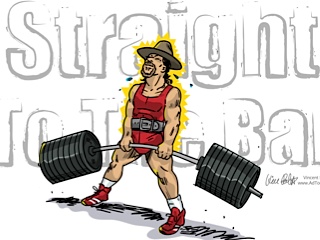
With most of the equipment in my home gym, the current setup is more than reasonable; however I’d probably change a few things if I was starting again. The humble Power Rack – the core of the gym – is no exception to this. If you’re about to buy one, here are a few things to consider.
Height
If you’re planning on doing any overhead work (Military Press, Overhead Squats etc), you’ll need a bit of headroom. This will require both a high ceiling and a tall rack (mine is about 7′ tall – high enough to stand in, but I’m forced to do seated versions of the above exercises).
For chin-ups, make sure there’s enough room above the rack for your head to clear it comfortably (particularly if kipping’s your thing). Also check that there aren’t any light fittings overhead (sounds obvious, but you’d be surprised).
Weight, weight stands
Nearly every rack on the market these days will comfortably take several hundred kilos. This is fine for most people, and the small percentage of the population who demand heavier weights (and I really can’t blame them) will probably already have their favourite rack picked out. If not, take a look at these over a EliteFTS.
On a side note, it can be extremely handy to have a few bars on the rack itself to hang plates on. Especially once you get into your work sets.
Attaching bands
Whilst you can always loop bands over heavy dumbbells, hooking them directly onto the rack is much, much simpler. If you regularly use bands in your training, a rack with a selection of dedicated hooks or pins is definitely worth looking at.
Spacing of pin holes
One of the things that delineates the cheaper racks from the ones that people are seen drooling over in garages everywhere is the spacing of the pin holes (the holes down the side of the rack that the pins are placed in).
Within reason, a smaller gap between the holes allows for a greater degree of flexibility. Anything down to about 1″ is fine (the cheaper racks have a gap of 2″ or more).
Want to work on your sticking point from just there? Now you can.
NB : the spacing sometimes varies within the one rack. If it does, the finer spacing will most likely be in the middle of the working range; where it can be used to your advantage.
Extra J-hooks, extra pins
By default, many racks only come with a single pair of J-hooks (the hooks the bar sits in just prior to the lift). A second set can be extremely handy – for the other side of the rack (either internal or external).
Extra pins are also extremely handy for restricting the range of motion. For several great ideas on this see the Altering Barbell Kinetics ebook (free) I mentioned a while ago.
Width
Although the width of a barbell never changes (within one type, that is – standard bars are about a foot shorter than their Olympic counterparts), the width of racks vary from brand to brand. The rack’s minimum width will depend largely on what you’re going to do with it.
Sumo squats and rack pulls will take the most room; somewhere around 40″ would be an absolute minimum, but your best bet is to measure your own squat (outside one foot to outside the other).
If you intend to bench press in the rack, or use the bench as a seat for other exercises (such as the overhead work I mentioned earlier), make sure the bench fits. If you’re buying them both at the same time, great. Test them out.
One more thing to note with the bench inside the rack – if you plan to use dumbbells from the bench, make sure there’s plenty of room to drop the dumbbells once they get heavy. Oh, and something to protect the floor (in the drop zone) is always a good idea – a couple of rubber mats will do nicely.
Optional extras
Whilst the rack is an extremely versatile piece of equipment, there are a few optional extras that are well worth considering. These are :
dip bars : these often hook on to one of the pins, and will stick out from the rack about the same distance as a loaded barbell. alternate solutions make use of the free space in front of the rack.
lat pulldown : whilst this takes up some of your rack’s depth, it makes pulldown work nice and accessible.
step-up platform : although you can always use your squat box for these, a dedicated platform is both stable and always there. a great accessory.
storage hooks for bars : these are usually on the outside of the rack (to the rear), and ave very handy if you regularly use several different bars in your training.
storage hooks for bands and chains : these are generally on the sides of the rack (facing out), and are great for hanging the bands and chains you’re not using for that particular set.
Overall space in your gym
One final question – how much room will a rack take up in my gym?
As noted above, racks vary a little in size – particularly in width. If you allow enough room to walk around it, you’ll be fine. Happy shopping.










0 Comments
Trackbacks/Pingbacks